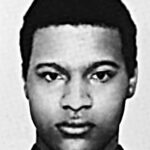Each December, some people respectfully recall Peorian Mark Clark, shot to death in an apartment 54 years ago this month in a Chicago police raid coordinated by the FBI and Cook County State’s Attorney’s Office.
This year the recollection is more intense, first in the face of the troubling trend of withholding history. One of Mark’s sister, Gloria, in her book “Mark Clark: Soul of a Black Panther,” wrote of her “concerted effort to make sure that Mark’s legacy is never forgotten nor lost to future generations.”
Next, somber memories of Mark are also noteworthy after the publication of an essay about fully appreciating the Black Panther Party written by longtime Chicago activist Marilyn Katz, who died days later at the age of 78.
“On December 4, 1969, an American civil rights activist, Defense Captain Mark Clark, leader of the Peoria Branch of the Black Panther Party, was assassinated,” Gloria wrote.
Born at St. Francis to a large family led by Missionary Fannie Mae and Elder William Clark, a Caterpillar molder who also was pastor of the Holy Temple Church of God in Christ, Mark was an athletic and artistic youngster mentored in part by Juliette Whittaker at Carver Center. He’s remembered as a bright 15-year-old who knew right from wrong and joined the NAACP and accompanied some of its members to 1963’s March on Washington for Jobs and Freedom. A few years later, the Manual High School graduate and Illinois Central College student was introduced to the Black Panther Party by a California relative and joined the organization.
“Mark decided that it was time to take a stand,” Gloria wrote.
In 1968 Mark established the Panthers’ Peoria branch, which grew to some 50 members and dozens of non-members who supported its work, such as the free breakfast program he arranged with help from the Rev. Blaine Ramsey and the Ward Chapel AME Church.
Mark befriended Chicagoan Fred Hampton, chairman of the Illinois Black Panthers, and though he became concerned that their lives were in danger, he went to Chicago around Thanksgiving in 1969. Weeks later, at about 5 a.m.
Dec. 4, a Thursday, police stormed the Monroe Street residence and shot Mark in the chest, killing him instantly and causing the gun he’d been holding to discharge as he fell.
It was the only gunshot not from police.
Chairman Fred, apparently drugged, was shot at close range with two bullets to the head as he lay in bed, unconscious.
State’s Attorney Edward Hanrahan described it as a gun battle and the Chicago Tribune published a photo Hanrahan provided supposedly showing bullet holes in walls. However, Chicago Daily News columnist Mike Royko went through the apartment and said Hanrahan was wrong, and the Chicago Sun-Times exposed the picture of “proof” there was a gunfight as false; the “holes” were actually nail heads.
In Peoria, the family wasn’t notified of the killing, as recounted by another sister, Elner Clark, who in 2020 recorded a touching 4-minute video reflecting on the family’s emotional response to the tragedy. (See her poignant personal memory at https://vimeo.com/487262958).
After the fatal raid, about 1,000 mourners attended Clark’s Peoria funeral, where Whittaker and the Rev. Ramsey spoke. Eventually, much of the truth came out after the family filed a civil-rights suit and 13 years later received a settlement.
Unsettled, of course, is the negative stereotype of violent Black Panthers, especially compared to their community organizing and programs that helped people before comparable government or philanthropic programs.
That’s what Katz sought to correct. She was a Students for a Democratic Society (SDS) activist and friend of Hampton who eventually became an author, filmmaker and influential consultant who helped Mayors Richard M. Daley and Harold Washington, and Barack Obama’s successful run for U.S. President.
After her October death, Father Michael Pfleger of Chicago’s St. Sabina Church commented, “I trusted her intelligence but also her consistency for issues of social justice.”
This fall, Katz wrote, “Black Panther Party members spent most of their time not in gunfights or gun-toting, but in creating, enacting and defending programs to be offered by the society they fought to bring about. [They] understood that addressing systemic issues required more than just protests. It required concrete examples of what could, and should, be. Panther-led programs not only provided much-needed assistance to underserved communities, but also highlighted the potential for positive change through grassroots efforts.
“Ever wonder where federally mandated and funded health clinics arose from? Or school breakfasts? Or adult education? Or government-subsidized day care? Or free legal services, food banks, and many other programs providing crucial lifelines to historically underserved communities?” she continued. “When you talk about day care, thank the free day care centers they ran.”
Advocating school lessons about the truth, Katz also cited Illinois Panthers’ efforts to create a “rainbow coalition” of Blacks, Puerto Ricans, Mexicans, Appalachian Whites and SDS members. The Panthers also were challenging street gangs to stop preying on marginalized communities and help with programs to benefit people. They’d been making inroads, but then the 1969 killings derailed progress. “The gangs remained,” Katz said.
Such a curriculum remains necessary at a time of exaggerations, lies and divisions.
“Many still don’t quite understand why is it that Blacks cringe at the thought of Whites waving Confederate flags or boasting Nazi swastikas,” Gloria wrote.
Buried in Springdale Cemetery, Mark is recognized with a plaque at Peoria’s African American Hall of Fame museum. People must insist on remembering the complete Mark Clark and the Black Panthers even as mourning continues.
As an adolescent, Mark said, comforting his sister Gloria to be strong, “Now stop crying.”



